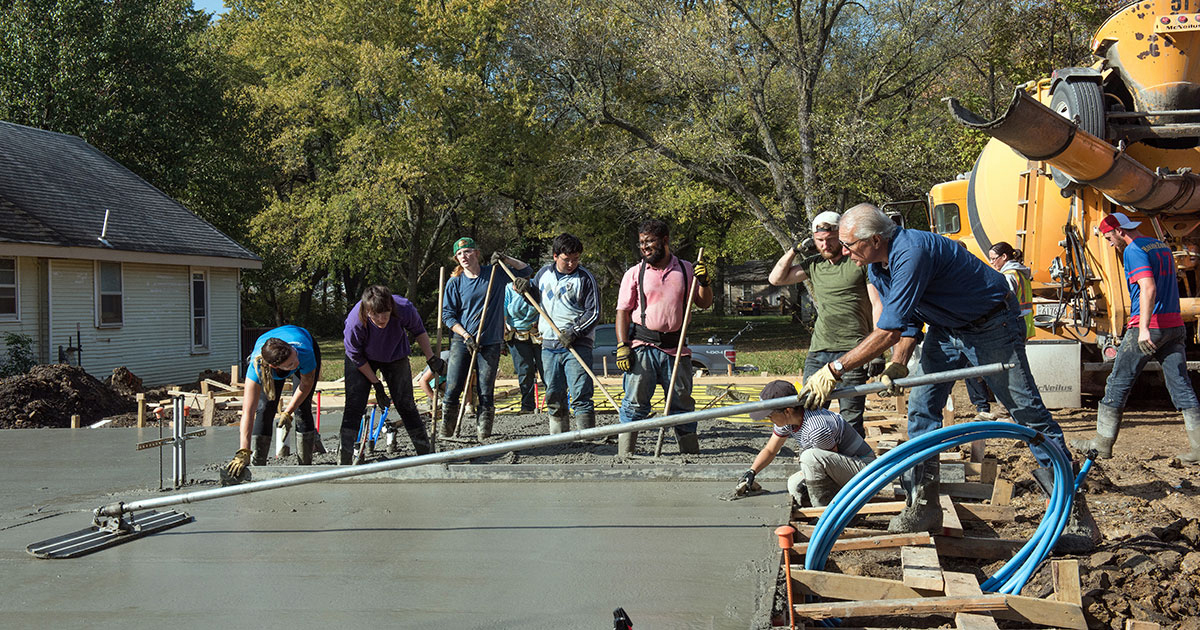Book documents do-it-yourself architecture of Studio 804

LAWRENCE — KU’s design-build “starchitect” Dan Rockhill is a big, gruff man dressed all in black, from his dusty work boots and coveralls to the wool scarf knotted under his neck (it’s cold in the warehouse this December morning, not to mention the job site), setting off his slicked-back white hair.
Inside the University of Kansas School of Architecture & Design’s Design-Build Center in the East Hills Industrial Park (Rockhill calls it “the warehouse”), sitting at a conference table in a walled-off space, the J.L. Constant Distinguished Professor of Architecture regards the 5.6-pound coffee-table book documenting the nearly 25-year history of the Studio 804 program he has led, transforming public and private spaces as well as the lives of its practitioners.
Using photographs taken by Rockhill himself and his words, edited by his professional partner in Rockhill & Associates, David Sain, the book covers such highlights as erecting the LEED Platinum-certified 5.4.7 Arts Center and community building in tornado-ravaged Greensburg, as well as work on modern homes in rundown parts of Lawrence and Kansas City. On-campus projects include the glass-walled Forum addition to Marvin Hall, home base of the architecture program.
The book is titled “Studio 804 Design Build: Expanding the Pedagogy of Architectural Education” (Oscar Riera Ojeda Publishers, 2018), and, as the title implies, it attempts to set down the initially ad-hoc, trial-and-error methods that Rockhill and his students employed to get the jobs done.
That includes establishing a separate, not-for-profit Studio 804 corporation and reaching an affiliation agreement with the university, whose leadership Rockhill credits as forward-thinking in this regard.
Growing organically from a series of one-off, semesterlong projects, Studio 804 has progressed to a yearlong, capstone course whose 10-20 sixth-year, masters-level students take their projects (this school year it’s two homes on one big lot) from concept to design through construction. The students do all the construction and subcontract little to nothing to get the job done. The residential projects are then sold at market rates to fund the next design-build cycle.
Rockhill’s text covers the ins and outs of dealing with the various stakeholders along the way, from assuaging neighborhood concerns over modern, infill architecture and gentrification to working with city leaders on permitting and the like.
When he started Studio 804, Rockhill and KU were among the first in the nation to offer such a hands-on design-build experience. A few schools have joined, and still more are interested, Rockhill said, which led him to produce a sort of guidebook. His peers see the success Rockhill has achieved, winning renown in the industry (projects have been documented in Architectural Record and Architect magazine, plus many other national and international media outlets) and finding a sustainable financial model.
That financial piece is certainly an attractive feature in an era of reduced state support for higher education, Rockhill said.
“This is all self-sustaining,” he said. “The only thing the university provides is this warehouse space, my salary and, of course, the kids.”
Rockhill said he realized he had something right away with the first 804 project, which involved the preservation of a historic, rural schoolhouse near Lawrence.
“I was amazed by what I saw,” Rockhill said. “They would pull their cars up around the building at night to shine their headlights on it so they could keep working. They were absolutely drunk on the experience. They just loved it. And, you know, when you teach long enough, you sort of notice these kinds of things. So I thought, ‘Well, that's interesting.’”
Not that every student relishes working on a construction site up to six days a week in all sorts of weather, pouring concrete and erecting forms, et al.
Rockhill admits he’s demanding.
“Sometimes they see me as the angry father,” he said.
But if they persevere, he believes, they’ll get the ultimate on-the-job training and “synthesize” their education.
“It’s the equivalent of the medical profession doing residencies and internships,” Rockhill said. “As I tell the students, I don't think there's another graduate in the world who's going to a job interview who can slide a book across the table — we do a little publication every year called Schemata — and say to the interviewer, ‘Oh, yeah, I just finished this. We designed and built it a few months ago.’
“In fact, one of our graduates was interviewing in an office in Philadelphia, and the architect just refused to believe she had done this. Hannah said, ‘Call Dan,’ and he called me while she was there. He said, ‘I just can't believe this.’ And I said, ‘Well, it's what we do.’ And I sent him pictures of Hannah working on the site. I think she ended up getting the job.”
Studio 804 has produced more LEED (Leadership in Energy and Environmental Design) Platinum buildings (they are working on their 12th and 13th this year) than any professional firm, something Rockhill prides himself on.
“Sustainability is a driving force behind what we do and like to demonstrate,” he said. “I think it is important that we as educators share with our students and the public what we see as the major issues of our times.”
Copies of “Studio 804 Design Build: Expanding the Pedagogy of Architectural Education” are available at the Jayhawk Ink bookstore in the Kansas Union, in the bookstores of the Nelson-Atkins Museum of Art and Kemper Museum of Contemporary Art in Kansas City, Missouri, and at The Raven bookstore in Lawrence.
Photo: Professor Dan Rockhill (right foreground) and Studio 804 students lay concrete for a 2016 housing project. Credit: Courtesy Studio 804